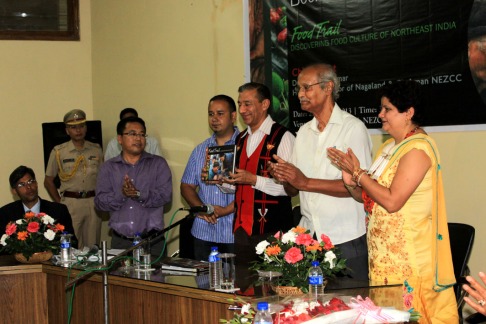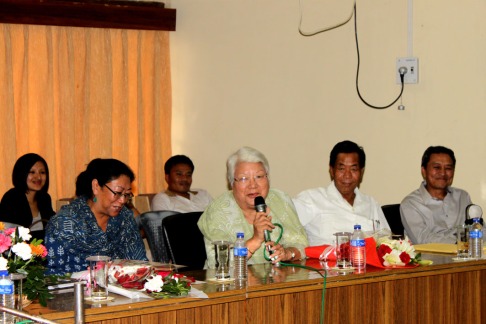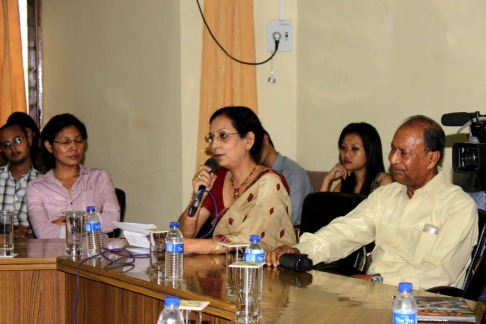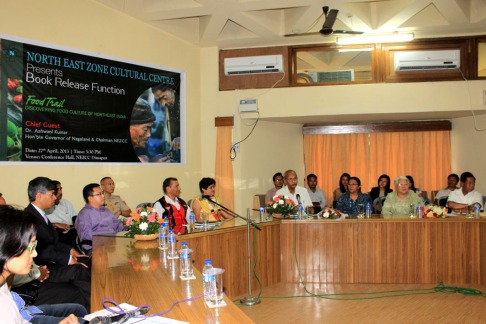Blog Archives
Nagaland Governor releases first comprehensive anthology on Northeastern food culture
Posted by Aiyushman Dutta
In a major boost to further exploration and debates on the food culture of the different tribes and communities of Northeast India, Nagaland Governor His Excellency Shri Ashwani Kumar today formally released ‘Food Trail: Discovering Food Culture of Northeast India’ – a first-of-its-kind anthology on food culture of Northeast India in the presence of a host of scholars, writers and distinguished personalities from various walks of life. The book, which has been conceived, primarily researched and compiled by writer Aiyushman Dutta, features a host of prominent voices from the region as also from different parts of the world. ‘Food Trail’ has been published by NEZCC, under the Ministry of Culture, Government of India.
Releasing the book, Shri Ashwani Kumar said, “This unique book has helped me understand and appreciate the diverse aspects of Northeast Indian culture from a totally new perspective. I urge everyone to buy this book and gift it to your near and dear ones.”
Distinguished anthropologist and Tagore National Fellow Prof AC Bhagawati, who has written the foreword of the book, termed the book as a novel and path-breaking venture. “Food Trail is a highly unusual book and a first-of-its-kind. Food culture is a huge subject and it is surprising very little has been done in this regard. NEZCC deserves praise for supporting such an innovative endeavour.”
A first-of-its-kind anthology, Food Trail: Discovering the Food Culture of Northeast India offers a peek into the life and culture of the people here through the prism of their food. Containing perspectives on subjects as varied as anthropology, sociology and literature, this book is a comprehensive database for those seeking to know about the social and symbolic role of food in Northeast India. Besides featuring narratives by some of the most respected voices of the region, the high quality aesthetic photographs provides for a visual delight.
Food Trail includes more than 30 insightful narratives by prominent Northeast Indian writers and researchers, including Prof Temsula Ao (Padmashree awardee), Easterine Kire, Kula Saikia, Anjum Hassan, Jahnavi Barua, Janice Pariat, Susan Waten, Dr Rabindra Teron, Dharam Singh Teron, Meenakshi Borkotoki, Cherrie L Changte, Jyoti Das, Karunamay Sinha, Bhaskar Phukan, Lalthansangi Ralte and many more.
NEZCC director Som Kamei said that the book was published in an effort of the centre to develop the cuisine industry of the region. He said, “Food is an integral part of every human culture. The importance of food in understanding human culture lies in its infinite variability – a variability that is not essential for species survival. For survival needs, people everywhere could eat the same and simple food. But human culture, over the ages, has been experimenting, innovating and developing sophisticated cuisines, which reflect human knowledge, culture, art and which have become an expression of love.”
Congratulating Dutta for his untiring endeavour to popularise the exquisite cuisines of Northeast India, Kamei said that the NEZCC had undertaken the task to not only popularise the cuisines of the region but also to document the various cultural milieu in which these cuisines have developed to become what it is today. “We hope that these rich collections of essays from experts and researchers will generate interest in the cuisine of the region and in the process, spark the potential cuisine industry and help in the overall development of cultural industries in Northeast India.”
Talking about the genesis of the book, Dutta said, “Most people in the world still relate food with general dietary habits and practices while the fact remains that food touches every facet of human life. The diversity of food as a subject can be gauged from the numerous and varied ways in which it affects people all across the globe – be it through nutrition, environment, economics, society, et al. Although, in recent years, a lot of interest can be noticed in the realm of food studies across the world, very little has been done on this subject in the country, barring of course a few well-documented essays and articles.”
He further said, “Given the huge expanse of food studies as a subject, ‘Food Trail’ can be described as an amateurish effort have a first-of-its-kind birds eye view of the social and symbolic role of food in shaping the life and culture of the people of Northeast and in determining their identity. But nonetheless, it is a beginning and I hope that that the well-researched articles are able to create renewed enthusiasm in the subject. I also hope that the government and agencies concerned realise the potential of the subject and support further documentation and study on the food practices of the region.”
In the open discussion that ensued, Padmashree awardee Prof Temsula Ao said that food is not only an unifier but also a divider. She dwelt on how Northeasterners were not allowed to take up houses on rent for cooking smelly food.
Also present in the gathering were Assamese cuisine expert Jyoti Das, Padmashree awardee Sentila Yanger, Music Task Force director Gugs Chihsi, Dr Ayangla Longkumer, amongst others. The event was conducted by popular Naga writer and columnist Susan Waten.
Rate this:
Posted in Uncategorized
Tags: Aiyushman Dutta, Anjum Hassan, Bhaskar Phukan, Cherrie L Changte, Dharam Singh Teron, Dr Ayangla Longkumer, Dr Rabindra Teron, Easterine Kire, food anthropology of northeast india, Food Trail: Discovering Food Culture of Northeast India, jahnavi Barua, Janice Pariat, jyoti das, Karunamay Sinha, Kula Saikia, Lalthansangi Ralte, Meenakshi Borkotoki, Music Task Force director Gugs Chisi, Nagaland governor Ashwani Kumar, Prof AC Bhagawati, Prof Temsula Ao (Padmashree awardee), sentila yanger, susan waten
BOOK WATCH: REBIRTH
Posted by Aiyushman Dutta
Of life and living
Jahnavi Barua, who shot into limelight a couple of years back with her debut collection of short stories, had earlier this year released her second offering in the form of her first novel, Rebirth, published by Penguin.
Though she had been kind enough to offer me a copy at the time of the book’s release, due to the various exigencies of life it was only recently that I managed to go through the paperback. But once I started, it didn’t take long for me to be overpowered by this gripping tale of love, redemption and self-renewal.
Rebirth is the story of a young pregnant woman, Kaberi, who is trying to come to terms with an unfaithful husband, an uncertain marriage and her own insecurities. The protagonist’s passionate communion with her unborn child reflects her frame of mind as she wades through the treacherous waters of love, betrayal, loss and self-renewal. Shifting between the urban bustle of Bangalore and the placid quietness of the Brahmaputra along urban locales in Assam, Jahnavi has weaved together an absorbing narrative marked by its lucidity and the profoundness of all that is left unsaid.
I guess the author Jahnavi Barua hardly needs an introduction. Trained as a doctor, she is now based in Bangalore from where she had written her first collection of short stories, Next Door, and which was very well received by critics and readers alike. Marked by her use of simple words and phrases, besides her disarming honesty, what sets Jahnavi really apart is her deep love for her homeland, something which she tries to reflect through the lives of her protagonists. The writer has done an excellent job in portraying the predicaments of contemporary urban life while at the same time, doing justice to her choice in maintaining her settings in Assam and parts of Bangalore, which the author professes to be her adopted homeland. From the abundant greenery in the grasslands of Kaziranga to the cosmic play of the nine planets in Nabagraha temple, her novel touches on almost all the aspects that a contemporary Assamese, or for that matter any person in the world, would be able to relate to.
Those who have read Next Door would identify Jahnavi as a sensitive writer. It is this very sensitivity – the writer’s subtle handling of human emotions while still maintaining simplicity in the narrative – that marks Rebirth.
Conflict, both internal and external, being one of the chief requirements of storytelling, is another area where Jahnavi has shown remarkable hold. Her subtle portrayal of conflict in the minds of her characters, especially the protagonist Kaveri, and the profoundness of all that she does not put in words lingers long afterwards in one’s mind.All said and done, I would term Rebirth as a wonderful and moving book which has elevated Jahnavi to the top rungs of contemporary Indian writers in English.
Rate this:
Posted in Concerts/ Reviews, Day-to-Day, Personalities/ Interviews
Tags: Aiyushman Dutta, jahnavi Barua, next door, penguin, rebirth
Storyteller of the Red River…
Posted by Aiyushman Dutta
Asom’s glorious and chequered history has been the pet subject of writers, artists and other creative professionals alike for a long time now. Not only have litterateurs beautifully exploited the rich and varied traditions and diverse cultural history of the State, they have also successfully raised the standard of regional literature to an altogether new high. Though a lot has been written on Asom, its history and the chaotic situation prevailing in the insurgency-stricken State, it remains a fact that very few writers working in English have taken the pains to document the life and essence of the people living here. Meet Jahnavi Barua the doctor-turned writer, who is creating waves in the national literary scene with her debut collection of short stories, Next Door. Jahnavi is special, for besides being one of the very few homegrown talents to have made a mark in the national literary scene, she has also successfully managed to shift the focus of people from the State’s political and social insecurities to something more vital — the very beauty and grace of the lives of the people residing here, and the overpowering Brahmaputra, which floods the novel with its force.
Jahnavi’s debut offering, Next Door, is a collection of 11 short stories, all set in Asom, which neatly strings together a multitude of characters and situations, with the varied nuances and settings of the State colouring the background. In this mesmerising collection of fictitious tales, the author expertly plays around with words, thereby opening up an entirely new dimension for Asomiya writers working in English, besides creating the best possible dialogue between the characters and the locale. With Next Door, Jahnavi weaves a sensitive portrayal of a varied set of characters, while the universal themes ensure that the compilation, despite its Asom settings, can be transposed anywhere and everywhere. Apart from anything else, the book, which has been very well received throughout the country, has marked the emergence of another prolific writer from the State.
Presently based in Bangalore, Jahnavi is married to Anand Shyam Barua and both are blessed with a seven year old son. I recently sat down with Jahnavi for a tete-a-tete. Following are excerpts from our discussion.
Aiyushman: Could you please share with our readers something about your childhood?
Jahnavi: I was born in Guwahati as the first child of Bhaskar and Krishna Barua. At that time, my father was posted in Shillong and I spent the first few years of my childhood in the bustling household of my paternal grandparents in Laban. My great-grandfather Late Raibahadur Kamala Kanta Barua’s house – ‘Kamala Kareng’, which is now over a hundred years old – contracted and expanded with the comings and goings of other family members and that closeness has remained a constant feature of our large, extended family. After a couple of years there, my parents and I moved to the picturesque hill-town of Haflong where my father took charge as the DC of North-Cachar Hills. The beauty of that quiet town stayed with me and I have worked it into some of my stories. While we were there, my brother, Deepak, was born. Within a couple of years, we moved back to Shillong and a few months later to Guwahati, where my father assumed charge as DC, Kamrup.
It was there, in that bungalow above the river, that I fell in love with the Brahmaputra and I have carried its images with me throughout our later nomadic existence. The river appears in almost my works, a sort of leit-motif, a constant friend and a symbol of the incredible beauty of my homeland. My sister, Padmaja, was born during that stay in the bungalow above the river. There followed more wanderings – few years in Delhi interrupted by a brief sojourn in England, in Manchester, then back again to Asom, this time into the thick of the Assam Agitation. From Asom, I then made my way to Bangalore to study and work in St. John’s Medical College. Even after marriage my wanderings did not cease: we lived in Ahmedabad, Cohin and Kolkata before making our way, this time, back to Bangalore , where I live now. My childhood , therefore, has been a full one, packed with new places, sights and experiences but in the background constantly flowed the warmth of our large extended family, providing me with stability and grounding and a strong sense of place and identity.
Aiyushman: You are a trained doctor. Why the sudden transition to full time writing?
Jahnavi: I began my MD in Pathology, enjoying tremendously the richness of the subject I had chosen. But when, after my marriage, my studies required me to stay on in Bangalore, while my husband moved as dictated by his professional requirements, I rethought my plans. There was absolutely no pressure from anybody – people assume that family pressure led me to reconsider my path in Medicine. It was not pressure at all, but considerations about family that prompted me to discontinue my work in Medicine. I realised soon on, that my husband’s career would require us to move around, and I was clear I would move with him. At the same time, I knew that such a life would not allow me to sustain a credible medical career. After all, a year in one place and two years in another was not the kind of hospital experience I was looking for. So, I turned my attention to another critical aspect of life: raising a family and that is what had occupied me since.
We have a son, Arjun, who was born while we were in Calcutta and who is now seven years old. It was during the early years of looking after my son that I took to writing. For long periods of time, I was housebound which led me to read a lot. After much reading, I somehow began writing short stories that I absolutely did not think of publishing. I somehow had the impression then that no one published short stories – and they remained tucked away in a folder, until one day I submitted one of them, for a competition hosted by a publisher called Unisun publishers and the British Council. That story won the first prize, the British Council gave me a Charles Wallace Trust Fellowship and that enabled me to go on to a Creative Writing workshop in the UK conducted by the Arvon Foundation. I continued to write, was picked up by Penguin and that was how my first book, Next Door, a collection of short stories came about.
Aiyushman: One of your first awards was for a short story that you had written for The Sentinel. Would you please elaborate a bit on this front?
Jahnavi: The award from The Sentinel was the first public award for Creative Writing that I had received although I had received prizes in school before that. It was when I was in High School that the Sunday supplement of The Sentinel announced a short story; I joined, my story was called The Face at the Window and it won the second prize.
Aiyushman: All the stories in Next Door seem to be annotated by disease and death. Is this a result of your profession as a doctor?
Jahnavi: I, for one, do not think that all my stories are annotated by death and disease. In this collection of eleven stories, there are six stories (River of Life, Sour Green Mangoes, The Patriot, The Favourite Child, Tiger and Next Door) that are not about death or disease. In The Favourite Child, the real story is not about the dying mother but what is happening around her. As for the rest they have as much to do with death and disease as real life has, since my stories are representations of life in the real world. The themes of the stories have little to do with my profession as a doctor.
Aiyushman: You make strong references to certain areas of Asom which outsiders are not able to relate to or recognise that easily. Was it intentional?
Jahnavi: The stories have been set in places that the plots demand; the locations have not been chosen with the intent of either avoiding well-known landmarks or with the hope of attracting an outside audience. Tiger, is one story that has been located in a place that is instantly recognisable – Manas National Park – but that is again because the plot required it to be set there. However, one very visible landmark flows through almost all my stories: the Brahmaputra; its beauty and power and unpredictability a metaphor for life in Asom.
Aiyushman: Most of the characters in your stories are shown to be in some conflict with their own selves or families. Is this some sort of reflection of the conflicts of familial and social life in modern Asomiya society?
Jahnavi: Conflict is one of the central requirements of storytelling, be it in the novel or in short fiction. In fact, it is constantly emphasised that there can be no successful story without conflict; the reader fully relishes a story only when there is conflict and that tension is subsequently resolved. Hence, each of my stories has at its core, a conflict, be it the protagonist’s internal conflict or versus family or society or environment. This conflict is not a reflection of modern times but is an eternal one, being around ever since man has existed.
Aiyushman: How did you handle a delicate subject like insurgency, to which you made certain references in your book?
Jahnavi: The subject of insurgency has been addressed in depth and more skilfully by many accomplished authors in other Indian and Asomiya literature; it comes into my stories only obliquely, as a part of everyday life in Asom. I have not written a story around that theme but as and when it requires the political situation collides with the lives of the characters in a story – very much like our lives today in Asom.
Aiyushman: Your stories are highly moving emotionally. Is it an extension of your own self?
Jahnavi: As a reader, I have always particularly admired literature that reaches out and touches a person and I have attempted to do the same in my writing.
Aiyushman: All the characters of your stories are vastly different from each other. How do you go about deciding your characters?
Jahnavi: It is always a challenge to step into the skin of different characters and be able to detail them convincingly – especially when they are far removed from you. For instance, it was tough to visualise an old man or a young man from a vastly different background. It required hard work but I was prepared to do that and I suppose that and a lot of patient observation is what helped me sketch out my characters.
Aiyushman: What aspects do you try to keep in mind while writing short stories?
Jahnavi: There are a few basic elements of the short story that a writer has to keep in mind when writing one – the plot, the characters, the setting, the tone of the story and dialogue. I try and ensure that the plot is a convincing one so that the story comes across as one with depth. Again as far as characters are concerned, I attempt to build up a credible character with a voice that is believable and that resonates with anyone reading about them. The setting, which is the physical location of the story, is something which I consider to be very important and I try to describe it and relay its flavour as accurately as possible. In the same context, I try and create a dialogue that is a good match with the characters and the locale. In the end, I try and write a story not only with the above elements in mind, but also with integrity so that it moves and touches the person reading it.
Aiyushman: What kind of literary influences do you have?
Jahnavi: There are so many that it would be hard to list all of them! My interest in short fiction led me to the works of writers such as Anton Chekov, Alice Munro, Raymond Carver, Richard Ford, among many others. My mother was a student and teacher of English Literature, in fact, her doctoral thesis is on Indian women writing in English, and that fuelled a lot of reading and discussions in our home while we were growing up and that has always led me to seek out books.
Aiyushman: Any suggestion for other aspiring writers from the region?
Jahnavi: Being a new writer myself, I will not presume to give any advice. But I would definitely like to say that honest writing from an author who knows his or her own voice well will always find a place.
Rate this:
Posted in Personalities/ Interviews
Tags: Aiyushman Dutta, assam, Brahmaputra, insurgency, jahnavi Barua, next door, writers






